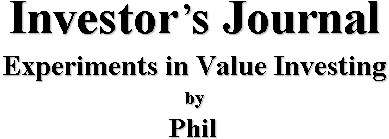Home
Previous
Next
February, 2022: 28

Disclaimer - IMPORTANT - Read this first!
| Investor's Journal is a diary focused strictly on investments and personal finance issues, primarily from a contrarian and retiree point of view. Follow along with an average guy's failures and successes as he learns, by trial and error, the fine art of value investing. |
2/28/22-The following asset was sold since 1/23/22: ZM. In its place, shares of BILL were purchased.
The updated basic 25 holdings: AWF; BDN; BGFV; BHK; BILL; CEFS; DDOG; DKS; EDV; EQTIX; FSPHX; HMY; MNDY; NLY; PCEF; PCN; QQQE; RIO; SLNH; S; SNOW; VIOO; VTI; WU; and ZS.
Our portfolio is on track to achieve a year-end total dividends target of $58,320. (Our ongoing intention is to have an annual 8% increase or better in portfolio dividends, from their latest base of $50,000 in 2020. The 2022 goal is thus $58,320 in total portfolio dividends received for the year.)
Liquid assets are down $11,840, or 0.58%, since 1/23 and, as of the close of trading on Monday, 2/28, stood at $2,027,844.
Our assets of all kinds (real estate, equities, collectibles, etc.) are down 7.96% since 12/31/21. The nest egg total is now $2,422,394. This is a $209,543 decrease from its level at the end of last year.
The S&P 500 is now off 9.23% from its 52-week high. Research has shown that an excellent time to buy stocks may be when the market has dropped 7% or more. On average, they get back to their prior highs within six months or less. On the other hand, it does not always pay to load up the truck with additional shares at such times. The S&P 500 Index, for instance, may go on to have significantly greater drops than this. Despite what folks may tell you based on their readings of charts, one actually never knows if the latest downturn will be that kind of circumstance.
Dollar-cost-averaging, however, buying a roughly equal amount of new stocks, stock mutual funds, closed-end equity funds, or exchange traded stock funds at regular intervals, assures one obtains more shares when prices are down, fewer when they are up, lowering the average cost basis.
Another approach that seems to work well is to simply review at regular intervals, for example every quarter, and purchase shares only when the review shows a market drop of 7% or greater. This has been shown to result in nice profits both for exchange traded funds (ETFs) based on an equal weighting of the S&P 500 Index, RSP being one, and for ETFs for the S&P 600 Small-Cap Index, VIOO often being suggested.
The funds may be held for the long-term or traded, bought when down 7% or more in the quarter being reviewed, and then sold at a desired profit level, perhaps when up 15% or more, after which one simply waits with short-term bond assets till the next 7% or greater drop in the S&P or S&P 600 Small-Cap Index.
Disclaimer and Disclosure Statement
Neither I nor Investor's Journal will be responsible for losses by anyone who obtained ideas from this site.
This diary is intended for personal interest and general information only. You are advised to do your own research (as well as to consult highly compensated professionals) before spending money on anything.
I know of no reason anyone should take my financial musings seriously. At best I am a dedicated amateur providing a bit of investment-related insight and entertainment, at worst an amusing diversion.
My wife, Fran, and I may at times own shares of some of the assets mentioned here. But neither of us receive any benefit from reference to them, unless you count the mutual misery when we get it wrong, or the opportunity to gloat when we get it right.